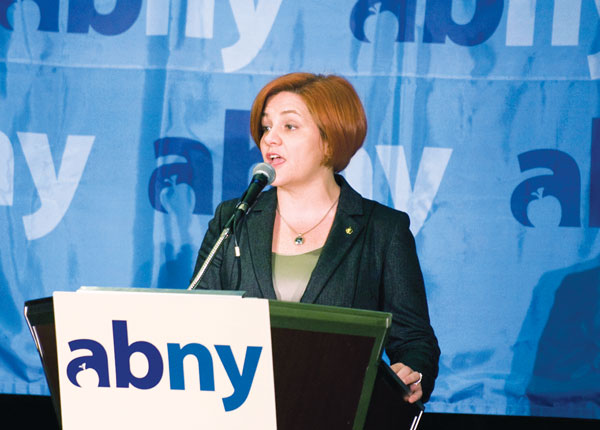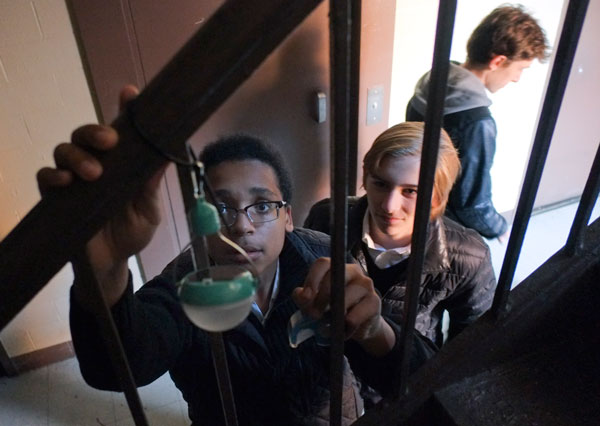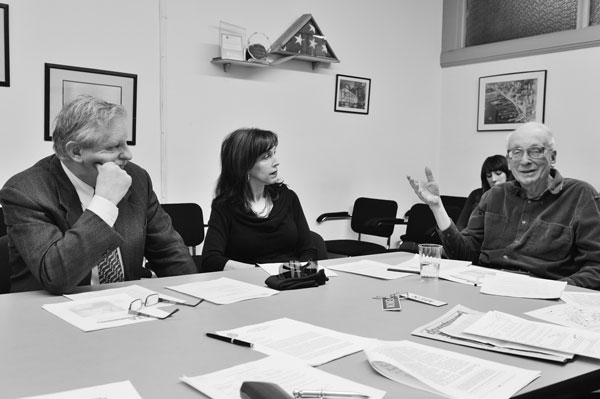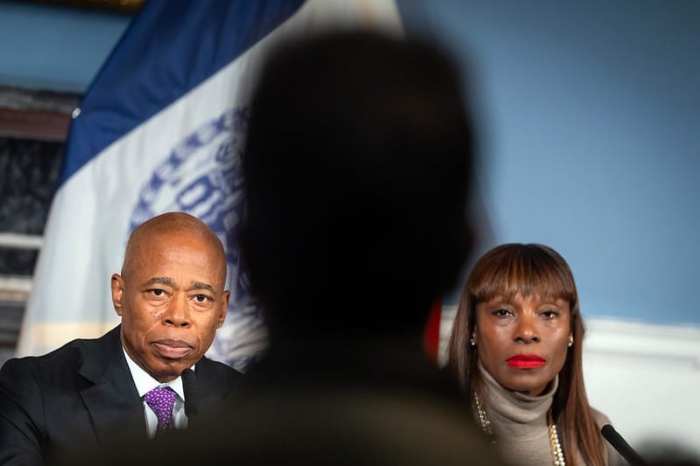
BY LINCOLN ANDERSON | Saying that strengthening New York City’s defenses to withstand the impacts of future Sandy-strength storms is “the single most important infrastructure challenge of our time,” Council Speaker Christine Quinn offered a sweeping blueprint Tuesday for critical planning and preparation in an era of global warming.
Her package of proposals to combat flooding ranges from massive, harbor-spanning, storm surge barriers to sponge-like, water-absorbent sidewalks.
In backing the barriers, which Quinn wants to be federally funded, she’s clearly breaking with Mayor Bloomberg, who feels it would be impossible to secure the necessary money. But Quinn this week announced she now has a more powerful ally in U.S. Chuck Schumer, who has pledged to ask the federal Army Corps of Engineers to study the idea — the first required step in the process.
“Two weeks ago we were reminded that our city is vulnerable to the forces of nature,” Quinn said, “that the reality of climate change puts our homes and our safety at risk. What we do in this moment will determine whether we allow that reality to define us, to hold us back — or to inspire us, to push us to do what we know is hard.”
Not only hard — but expensive.
It could cost up to $20 billion to surge-proof the city, under Quinn’s proposals. That price estimate includes one very “big-ticket item,” she said, namely, a storm surge barrier — strategically sited sea gates to hold back hurricane-force high waters.
“If we decide to install a storm surge barrier, it could cost roughly $16 billion alone,” she explained.
However, Quinn said, looking at the response to Hurricane Katrina gives some sense of the scope of federal investment that must follow a storm as destructive as Sandy. Congress authorized more than $110 billion in spending for the Gulf Coast, including $25 billion for New Orleans.
While acknowledging that Sandy was “a different storm than Katrina,” the speaker said that to many New Yorkers it was just as devastating.
“And just to put things in perspective, there are 360,000 people in New Orleans,” she said. “We have nearly half a million residents in Staten Island alone. We need the federal government to invest in our citizens, to help us rebuild New York safer than before. New York City suffered an estimated $26 billion in economic damage and losses. That doesn’t even take into account the losses we will suffer if we don’t rebuild correctly, if businesses flee our city because they think Lower Manhattan is too risky a place to invest.”

New York, with much of its huge population living right near the water, ranks number five among 140 port cities around the world in terms of vulnerability to flooding from storm surges. Forward-thinking London, for one, already has 10 enormous surge barriers in place on the River Thames.
But one need not look that far to find a municipality that has bought into barriers. A tony bedroom community has already safely surge-protected itself.
“Closer to home,” Quinn noted, “engineers in Stamford, Connecticut, with the click of a mouse, brought a storm surge gate rising up from the water as Sandy approached.”
Challenges the deniers
The ordeal that New York and the region just endured, and are continuing to suffer through, Quinn said, shows that global warming is real. And while the City Council has passed landmark legislation to reduce the city’s carbon emissions by 30 percent by 2030, that’s just “a drop out of the bucket” that will continue to fill due to global warming.
“Those who still deny the reality of climate change,” Quinn declared, “I challenge you —look in the eyes of New Yorkers who lost loved ones, who lost their homes and businesses. Tell them the science is inconclusive. Tell them that global warming is a myth.
“In the last 100 years, New York Harbor has already gone up 12 inches,” she continued. “According to the New York City Panel on Climate Change, sea levels are projected to increase roughly 1 to 2 feet by 2050 — and 3 to 4 feet by 2080. So if we don’t act now…flooding will be even more common… . And places that never had to worry about serious flooding will suddenly find themselves vulnerable in major storms.”
Quinn, an expected candidate for mayor in 2013, presented her vision in a speech in Midtown before the Association for a Better New York, a group including the city’s most influential businesses, nonprofits, arts and cultural organizations, educational institutions, labor unions and entrepreneurs.
Specifically, in her remarks, the Council speaker announced an agreement with the Bloomberg administration to accelerate the completion of two studies to analyze the flooding risks facing the city and the best protections. Both studies will now be completed by April 2013.
She also reported that Schumer will lead the effort in Congress — working with the Obama administration — to obtain an Army Corps of Engineers study that will conclusively assess whether or not to build storm surge barriers or other flood-protection structures here.
‘We need surge barriers’
“The time for casual debate [about surge barriers] is over,” she said. “It’s now crystal clear that we need to build protective structures. This will include both hard infrastructure, like sea walls, bulkheads or floodgates, and more natural defenses, like sand dunes, wetlands and embankments. And there are places where the best solution may be to raise the land above the flood plain.” Quinn said the work of building and strengthening these defenses “will go on for years, if not decades.”
However, quickly responding to Quinn’s advocacy for surge barriers, Bloomberg later on Tuesday said, “I don’t know where the money would come from. “It would take billions and billions of dollars. Before the federal government would get involved, you’d be doing it from the Florida Keys to the southern edge of Maine… . People just can’t do that.”
As well as the cost, the mayor has questioned surge barriers’ feasibility in a harbor as large as New York’s.
But, responding to the mayor’s comments, Quinn told the Daily News she’s confident the Obama administration will respond, especially since the city is the world’s financial capital.
In her ABNY speech, Quinn further said that Con Edison and other utilities — as well as cell phone providers — must better prepare to handle future storms and emergencies. Above all, Con Ed must improve protocols for when the utility decides to cut power to vulnerable substations.
“If they had shut off power to the 14th St. substation sooner, they would have avoided the explosion that caused long-term blackouts for hundreds of thousands of customers in Lower Manhattan,” Quinn noted of the utility’s East Village power plant.
In addition, Quinn said, all utility companies must erect structures around power plants and substations in at-risk locations to protect from storm surges “of at least 20 feet.” Sandy’s surge was 14 feet — 2 feet higher than Con Ed was prepared to deal with at the E. 14th St. power plant, resulting in Lower Manhattan’s four-to-five-day blackout from the E. 30s south.
‘And no Con Ed hikes!’
The speaker stressed that Con Ed must eat the cost of beefing up its own defenses.
“I want to send a clear message to Con Ed today,” Quinn warned, “we will not tolerate you simply passing these costs on to ratepayers. New Yorkers cannot be asked to pay more just to receive consistent and uninterrupted service.”
The speaker’s plan also addresses another chief complaint of Lower Manhattanites during the blackout: cell phone service being knocked out for many. In Sandy’s aftermath, AT&T and T-Mobile agreed to provide access to customers of both companies in impacted areas.
“At our request,” Quinn said, “they have agreed to make these emergency network-sharing agreements permanent, and we urge other wireless providers to follow their example.”
The region’s gas distribution network must also be upgraded to better withstand future storm surges, Quinn said. She noted that local chains, like Hess, Wawa and Sunoco, had a higher percentage of gas stations up and running faster, using backup generators, than international companies, like Exxon Mobil, BP and Shell. Quinn called on all oil companies to secure backup generators to keep pumps operating and to create a system for fueling them in an emergency.
In addition, the city’s sewer system needs to be improved to handle massive flooding conditions, she said. Currently, the city’s combined sewer system — for rainwater and wastewater — often becomes overloaded, causing sewage to be dumped into the city’s waterways, she said. During Sandy, the entire system backed up, leading, in some cases, to sewage coming out of drains in sinks and bathtubs.
Absorbent sidewalks
To help combat storm surges, the city also needs to speed up the installation of “soft infrastructure,” Quinn said, including green streets and green roofs.
“And we’re going to pass legislation requiring the city to use new pavement materials that absorb rainwater and prevent sewer overflows,” she added.
The transit system — above all, the subways — must be safeguarded against swamping, Quinn stressed. This can be done, she said, by installing raised buffers around subway grates and elevating station entrances a few feet off the ground. New technologies, like industrial balloons, can be used to seal off subway or car tunnels from flooding, she added.
Also, building code changes will need to be implemented, she said.
Quinn said the City Council will be holding a series of hearings in the coming weeks and months on all aspects of how the storm was handled, from public safety and healthcare to Con Ed.
“Our greatest danger is inaction,” she warned. “We stand in a unique moment that carries with it a unique opportunity. The future of our planet, the world our grandchildren inherit, depends on what we do in the months and years ahead.”

FEELS surge of satisfaction
Meanwhile, Chelsea community activist Bob Trentlyon — a leading advocate for storm surge barriers in New York City — felt a “surge” of elation at Quinn’s speech. Minutes after her office sent out a press release on her remarks at ABNY, Trentlyon forward it to his e-mail list with the tag line, “This is really a giant step forward!”
For the past three years, Trentlyon, 83, has almost singlehandedly sounded the alarm over rising water levels’ threat to Gotham, lobbying everyone from community boards to local politicians to Governor Cuomo.
“It’s just wonderful news,” Trentlyon said on Tuesday afternoon. “Getting Schumer to come along was a good move, because he has a good relationship with Wall St. — and Wall St. doesn’t want to get drowned out [by another storm surge].
“Chris Quinn is aware that this is probably the most important issue in a generation — and I would say, in the 21st century — for people living in New York City. It’s a wake-up call to all of us, that there’s probably going to be a lot more storms like this and we have to protect ourselves — and building storm surge barriers is a part of it.”
For the last two years, Trentlyon has been lobbying Quinn to support storm surge barriers, meeting and talking on the phone frequently with her staff members.
“But I haven’t really been pushing for her to make a statement on it,” he said. “She did this on her own.”
As for the politics behind the announcement about the Army Corps study, Trentlyon said Schumer let Quinn have the limelight.
“He obviously agreed to let her announce it — Schumer usually wants to be out front on things, but he let her do this,” Trentlyon noted.
Timing is right to ask
On the announcement’s timing, the veteran activist said people wanted to do it after the general election — and now is also the best time to push for the required Army Corps study and the funds, he added.
“Now is the time to do it,” Trentlyon said, “before people forget [how bad the storm was], and say it will cost too much money.”
Plus, he added, “There’s a limited amount of money in Washington. Other places got hit, New Jersey… . We have to get while the getting’s good.”
Bigger issue than Jamestown
Trentlyon is the founding president of the Chelsea Reform Democratic Club — Quinn’s home political club — and is supporting her for mayor. Yet, he admitted, many locals are “angry” at her over the City Council’s recent approval of a vertical addition by Jamestown atop the historic Chelsea Market. Nevertheless, he said, her political career should be looked at in the bigger picture.
“You have to judge people based on everything they do,” he said, “and not on any one issue. I’m well aware that someone in political life has to make political decisions. If that’s all they were doing, I wouldn’t support them. But Chris has her own value system.”
As for Quinn’s appreciation of Trentlyon’s efforts, Justin Goodman, a City Council spokesperson, said, “Bob Trentlyon has been an active participant and one of many members of the public to volunteer their time to add to our working knowledge of complex issues like climate change.”
David Gruber, chairperson of Community Board 2, also was impressed by Quinn’s speech.
“I like that she’s taking it seriously,” he said. “When you see how much of our area is surrounded by water, it becomes crucial to do something. There’s going to be more of these [storms]. I think she’s on track. She said the right things about building barriers and waterproofing our power stations so we don’t get flooded out.”
Stringer backs barrier study
Borough President Scott Stringer, another candidate for mayor, also supports requesting that the Army Corps of Engineers study surge barriers. On Sept. 12, nearly two months before Sandy, Stringer introduced a resolution at the Manhattan Borough Board — composed of representatives of the 12 Manhattan community boards — calling for the study, and it passed unanimously.
The resolution stated, in part, “Whereas, climate change will create significant challenges to New York City in the years and decades to come; and whereas, the potential increasingly exists for New York City to be hit by a major storm which could cause a tidal surge of up to 20 feet; and whereas, the flooding caused by such a surge, which happened in the 19th century, would be calamitous, particularly to those living within several blocks of the Hudson River; and whereas, sea gates have been built in London, Rotterdam and Venice to protect those cities, which could also be protective in New York City; and whereas, a study of both the potential for such a surge and an appropriate response would be prudent; therefore be it resolved that the Manhattan Borough Board requests a study by the Army Corps of Engineers for potential flooding related to storm surge in Manhattan and to explore the feasibility of installing sea gates and barriers.”
The resolution further stated that “climate change preparedness” be a part of environmental impact statements for all new projects in New York City.
Sends surge of e-mails
Getting back to Trentlyon, he was asked if, now that he has achieved his main goal of building political momentum for at least studying storm surge barriers, if not installing them here, he felt his work was finished. He laughed.
“I’m going to keep doing it,” he said. “I’ve built up a little community of people who get my e-mails — I’m practically in the communication business. I think it’s important that people get more and more informed. I used to send out one e-mail like once a month. Now, it’s like once every other day I can send something out,” he said, quipping, “I may need an assistant to handle this.”THE KITCHEN



































